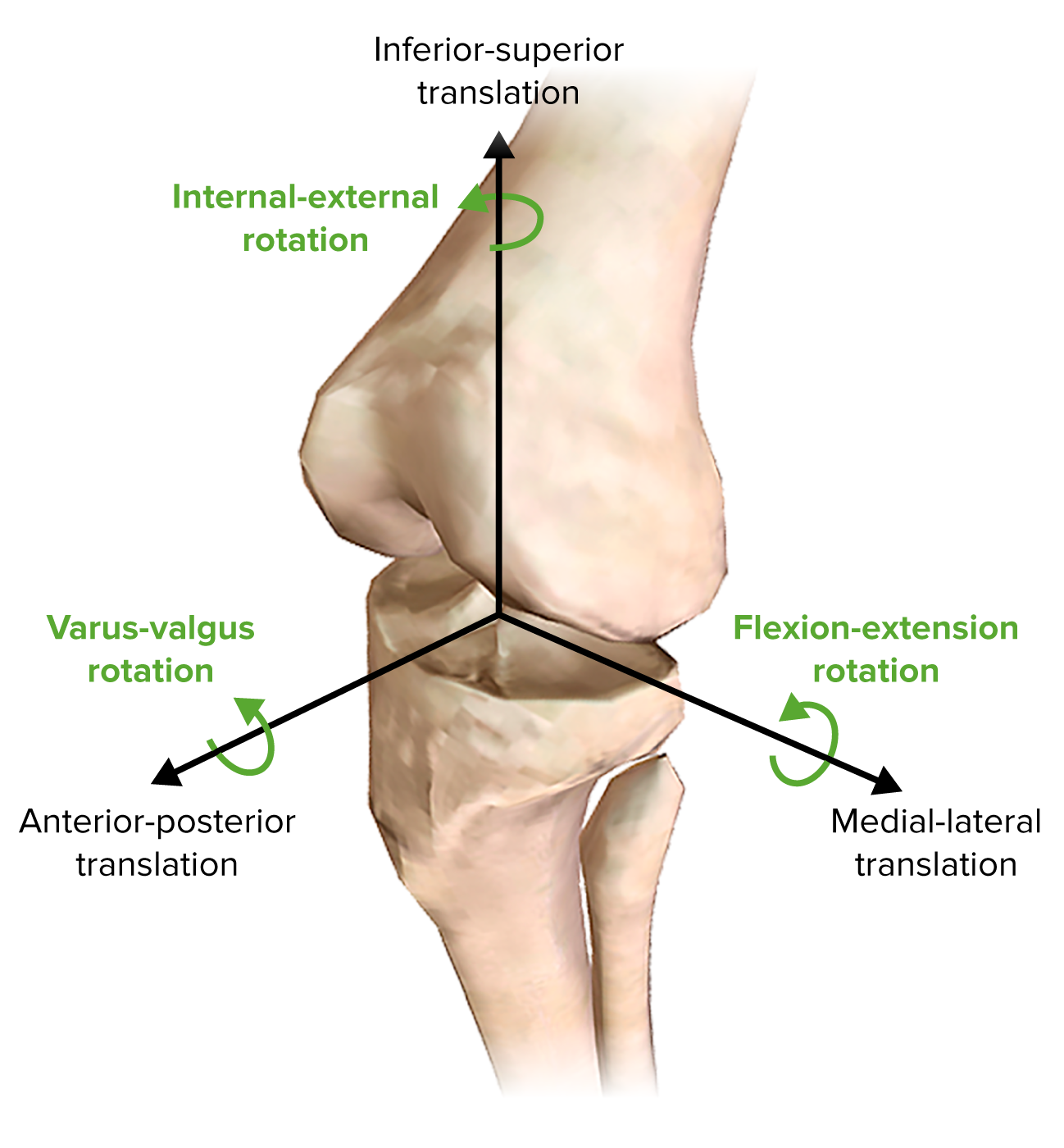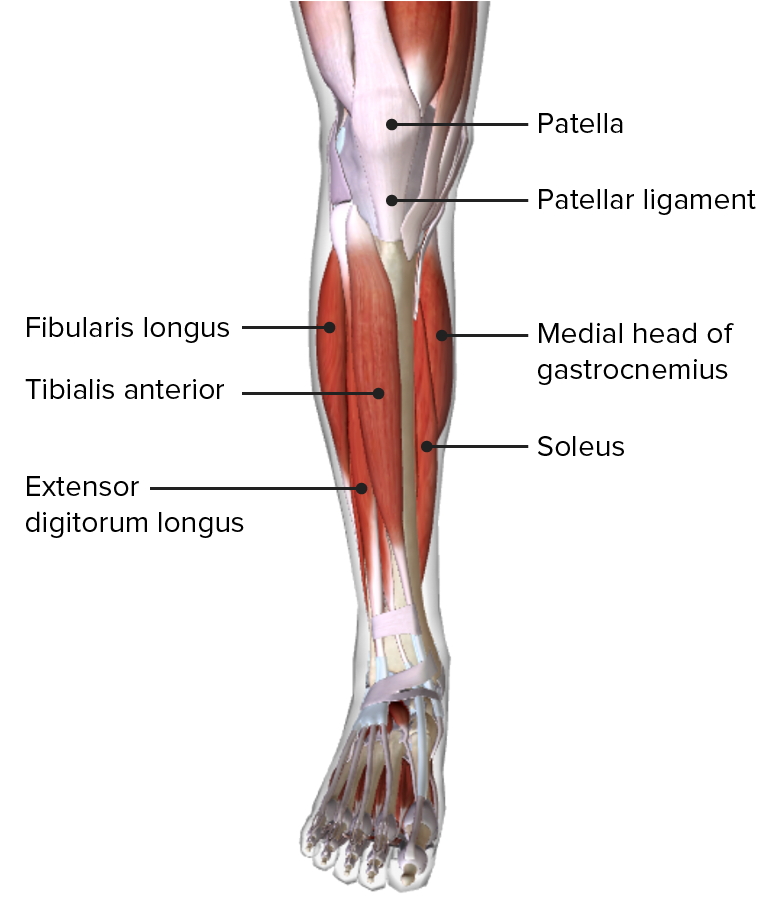Playlist
Show Playlist
Hide Playlist
Tibia
00:01 Now let's continue our journey with the bones of the lower limb and look at the tibia. 00:06 So here we've got the anterior surface of our right leg. 00:10 And you can see we have the medially positioned tibia, and then the fibula is positioned more laterally, remembering that the fibula doesn't have a role to play within the knee joint. 00:20 So got the tibia and fibula, forming the bones of the leg. 00:25 Here we can see the tibia as got a very similar structure to that of the femur. 00:30 So it has a proximal end of shaft and a distal end. 00:33 Let's look at those in more detail. 00:36 So here we're looking at the proximal end of the tibia. 00:39 We can see its articular surface which is going through articulate with the condyles of the femur. 00:44 And we have similar names, we have a lateral and a medial condyle. 00:48 So those dilations which enable that increased bony congruency between the two surfaces. 00:55 Most anteriorly, we have the tibial tuberosity. 00:58 And that's an important attachment site for the tendon that's coming down from the thigh through the patella, so it attaches the tibial tuberosity. 01:06 There's a quadriceps tendon continues through the patella onto the patellar tendon. 01:11 Here we have in between the two medial and lateral condyle. 01:15 So in between the two condyles, we have the intercondylar eminence, and then we can see this tibial plateau really this broad aspect which is the articular surface. 01:26 Here we can see the articular surface in more detail, the medial and lateral condyles and anteriorly to orientate ourselves. 01:33 In this view, we have the tibial tuberosity. 01:36 Again, here's the intercondylar eminence. 01:39 What we have in this region is important landmarks for various ligaments to attach to and again, we'll come back to that when we look at the knee joints specifically. 01:47 But here we have the anterior intercondylar area and we have the posterior intercondylar area. 01:52 Important attachment sites for our cruciate ligaments, which again, we'll come to in the knee joint, but important attachment sites. 01:59 So remember their name and their location. 02:02 If we then have a look at the shaft of the tibia, we've got an anterior view and a posterior view. 02:07 Here we've got a nice broad anterior border, there we can see it as a sharp ridge that's coming along, giving way down to the lateral border and to the medial border, we can see there as well. 02:19 So we've got a sharp anterior ridge forming that border. 02:22 And you can see it's kind of broadly sweeping down from the tibial tuberosity all the way down the shaft, but it's quite an elevated ridge which means we then have a medial border and a lateral border on the sides of that ridge we can see there. 02:35 This gives rise to the lateral and the medial surface, very similar to what we had on the posterior aspects of the femur we saw previously. 02:44 Then on the posterior surface, we have a smooth flat surface which we've got this posterior surface here, there's a slight line called the soleal line. 02:53 And that helps with the position of the soleus muscle which we'll see in a moment or two when we look at those muscles. 03:00 Okay, if we move on to the distal end of the tibia, here we can see we have a distal tip and then a medial malleolus. 03:08 Notice that you don't have a lateral malleolus because this time, the tibia and the fibula formed the ankle joint. 03:16 So the lateral malleolus is actually located on the fibula. 03:20 Here we can bring in the fibula. 03:21 And we can see how the fibula and the tibia unite there with the tibiofibular sydesmosis we can see a union between those two bones there. 03:30 And here, we can now see we've got the articular surfaces. 03:33 So this is the articular surface that's articulating with the ankle joint. 03:37 And again, we'll come back to that later on, specifically with the talus of the tassel bones within the foot. 03:45 So we're gonna see the articular surface of the medial malleolus and the articular surface of the lateral malleolus, which you can see on the underside of the fibula. 03:54 And here when we introduce the talus of the foot into this region, you can see how it forms the ankle joint. 04:01 Therefore, what I didn't mention previously because it wasn't there, but now we can see the lateral malleolus. 04:06 If we go back to the previous slide, we can see we have the articular surface of the lateral malleolus. 04:11 You can see indicated on the undersurface as we bring that in, you can see that lateral malleolus there. 04:17 So notice the tibia doesn't have a lateral malleolus, but the fibula does. 04:21 And notice how the fibula doesn't have a medial malleolus but the tibia does. 04:26 Together they form those two malleoli that enable articulation with the talus at the ankle joint.
About the Lecture
The lecture Tibia by James Pickering, PhD is from the course Osteology and Surface Anatomy of the Lower Limbs.
Included Quiz Questions
What are the attachment sites of the cruciate ligaments? Select all that apply.
- Posterior intercondylar area
- Anterior intercondylar area
- Tibial tuberosity
- Medial condyle
- Lateral condyle
Where is the soleal line located?
- Posterior surface of the tibia
- Posterior surface of the fibula
- Lateral surface of the tibia
- Medial surface of the tibia
- Medial surface of the fibula
Customer reviews
5,0 of 5 stars
| 5 Stars |
|
5 |
| 4 Stars |
|
0 |
| 3 Stars |
|
0 |
| 2 Stars |
|
0 |
| 1 Star |
|
0 |





